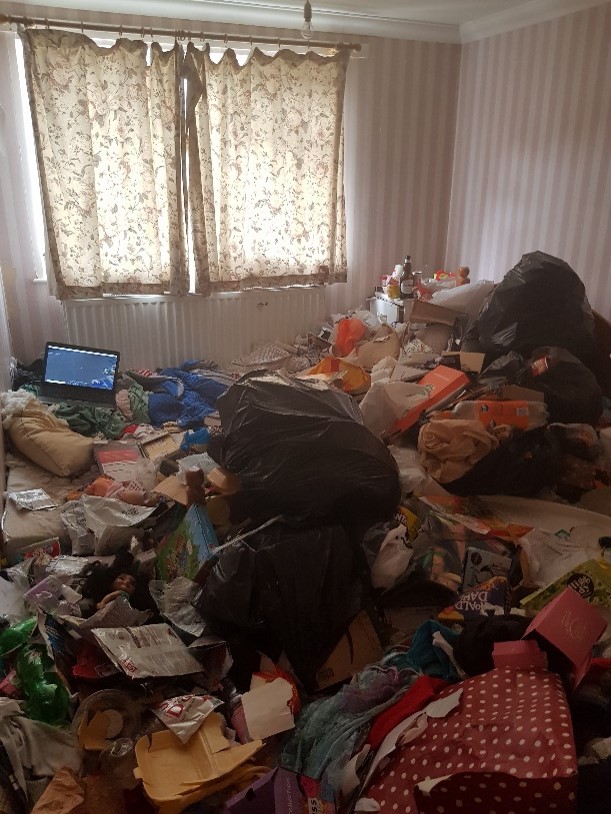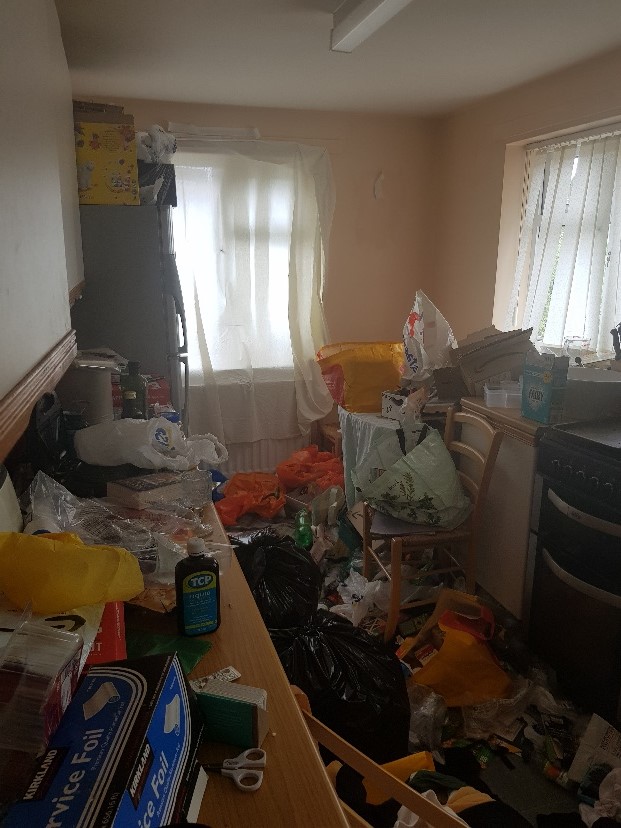Sensitive handling of a hoarding clean up in North London
Residential property owner, North London Summary
• Hoarding clean up and decontamination
• Discreet and sympathetic service
• ATP tested and certified result
• Health risks of hoarding eliminated
THE CHALLENGE
You don’t always think of a professional cleaning company when excessive hoarding is an issue. However, a hoarding disorder can be a significant long term problem, which poses health risks due to food waste, litter or animal waste creating unhygienic conditions.
At Ideal response, we understand how tough it can be to face up to hoarding and begin to resolve it. Most people don’t know where to start or where to go for help. So we offer a completely discreet and judgement-free cleanup service from start to finish.
Our residential client in North London had been fighting depression for years and as a result was also suffering from hoarding issues. Bravely, she decided get help for her depression and also to come to terms with her hoarding, by contacting Ideal for help. Our challenge was to efficiently and sensitively handle a complete clean up for the client, and ensure that her premises were fully decontaminated and safe again.
THE IDEAL SOLUTION
The hoarding cleanup in North London centred on a 2-bedroom flat where the client and her daughter lived. Our client had removed all important items from the property so that our team were able to clean freely and thoroughly without concerns over disposing of items of value or importance.
We had agreed beforehand that the client would not be present at the property when the clean began, to give our team enough room to work and to ensure there was no second thoughts about the clean up.
The first stage of the clean was removal of waste, with the team working in all rooms of the property collecting rubbish and clutter in heavy duty bin bags for removal from the property.
We then performed a deep clean, ensuring all floors were hoovered and all surfaces cleaned and decontaminated. This scope of this work included cleaning and decontaminating the bathroom and kitchen of the property.
Once the removal of rubbish and cleaning has been completed, the Ideal team tested surfaces in the property using ATP testing. We used this swab test on surfaces throughout the property since it enabled us to see exactly how effective our clean had been. ATP testing also gives our customers extra peace of mind knowing that their property is completely clean and safe and ready, for example, for food preparation.
Once our customer had returned after the clean, she was happy and overwhelmed with the results of the clean and her home’s new tidiness. It was a great pleasure for the Ideal team to be involved in this hoarding clean up in North London, and to be able to help people through a difficult situation and pay back the trust they put in Ideal Response to get the job done.


THE HEALTH HAZARDS OF HOARDING
A hoarding disorder can be a problem for many reasons since it creates mental health problems, causes difficulties of moving around a home, leads to isolation due to a reluctance of having visitors, and much more. From a health perspective, hoarding also making cleaning difficult, which can lead to unhygienic living conditions.
Some of the key health hazards that could have been associated with the hoarding clean up in North London are:
Air quality issues
With an increase in clutter comes the inability to clean and dust thoroughly and regularly. Naturally, this allows more dust to settle, and dust and odours from hoarded materials can then aggravate existing conditions such asthma and allergies. Respiratory issues are sadly quite common amongst hoarders and occupants of their households.
Mildew and mould
Should hoarded materials come into contact with moisture through unnoticed leaks, spillages and water penetration, mildew and mould become a serious health risk. According to the Housing Health and Safety Rating System (HHSRS), mould is a Category 1 risk – giving it the same risk factor as asbestos. There is also the risk of spoiled food and empty takeaway containers harbouring mildew and fungus growth. And pests such as cockroaches, flies or even rats will quickly be attracted to the same rotting food causing further health dangers.
Fire hazards and blockages
Many combustible materials can be part of hoarding, and these materials risk igniting if kept close to radiators, electrical outlets, cookers etc. They can also clutter pathways throughout a home creating the risk of falls, particularly to the elderly, and blocking exits in the event of fire.
Animal hoarding
It is not uncommon for hoarders to also have pets, or for animals to be the thing they actually hoard. Animal hoarding can range from cats and dogs but also include reptiles, rodents, birds and exotics. Clearly if hoarders amass a large number of animals, they will not be able to give correct animal care, and overcrowded conditions will lead to the spread of disease amongst the animals. Animal urine and faeces that are not cleaned up will also cause a host of health risks to both pet and owner and makes the perfect breeding ground for infection-transferring bacteria.
Neighbouring properties
Neighbouring properties are also at risk. Not only from the spread of fire and structural issues, but also from vermin. Huge amounts of clutter (and not uncommonly food waste), combined with mould and decaying building materials will attract pests such as rats, cockroaches, mice and flies. This infestation can quickly affect neighbouring and adjoining properties.
In severe situations of hoarding, Ideal can assess how best to tackle the problem in an effective, understanding and professional way. If biohazards are present it can actually be dangerous to clean a hoarder’s home on their behalf, since you could be exposed to a mix of different contaminants and risks, such as mould, broken glass, animal waste and other materials.
Instead, expert advice should be sought – the Ideal team are trained and have experience in dealing with all the dangers associated with hoarding and are fully equipped with the right PPE and cleaning materials. We are also here to help clients take things at their own pace and not pressurise you to undertake a hoarding clean up until you are ready.
THE TECHNICAL BIT
At Ideal Response, we don’t assume things are clean because they look clean. We apply systematic, reliable methods to test for different sources of contamination in properties affected by fire, flooding, trauma or spills – or in this case, the long-term storage of waste and clutter. Left untreated, these materials could allow organic matter, microbes and other harmful pollutants to pose health risks to people in a domestic environment.
Our testing methods identify the presence of micro-organisms known as ATP (adenosine triphosphate). The presence of ATP on a surface indicates improper cleaning and/or the presence of contamination, including food residue, allergens and/or bacteria which would be relevant in a hording clean up. So we use ATP testing before and after to confirm that the ATP presence is eliminated or minimised by effective cleaning procedures.
In this case, we could validate to our customer that the hoarding clean up in North London had been successful and that there was no longer a health hazard in any room of the property including the kitchen and bathroom. Following ATP Testing, we also provided certification of the effectiveness of our entire deep clean process.



